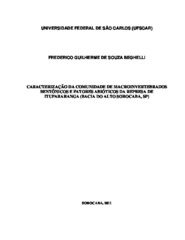Caracterização da comunidade de macroinvertebrados bentônicos e fatores abióticos da represa de Itupararanga (Bacia do Alto Sorocaba, SP)
Fecha
2011-03-14Autor
Beghelli, Frederico Guilherme de Souza
Metadatos
Mostrar el registro completo del ítemResumen
The objectives of this work were the benthic macroinvertebrate community characterization from Itupararanga Reservoir, High Sorocaba Basin, SP, Brazil and the identification of the main abiotic factors wich affects the structure and distribution of those organisms. Samplings were taken with Van-Veen grab three times (cumulative samplings). The samplings were taken at three reservoir‟s zones: riverine zone, transitional and lacustrine ones and at two regions: litoral and central ones. Furthermore, it was taken samples during the wet (December 2009 and February 2010) and dry seasons (June and August 2010). The dissolved oxygen concentrations, electric conductivity, pH, transparency and depth near the bottom were reccorded in situ by using a multiprobe and Secchi disc in all sample points. With the objective to verify witch environmental variables would be the most important for the benthic macroinvertebrates community characterization, a correspondence canonical analisis (CCA) was done by the main taxa density logarithm and the water and sediment variables data matrix. The total number of reccorded taxa was 28. The Diptera family Chironomidae was the richest group (19 taxa). The Tubificinae (Clitellata, Naididae) were numerically dominants during the wet season and the Chironomidae (Diptera) were it during the dry one. Similarity analysis was performed in order to test the spatial heterogeneity hypotesis even in the longitudinal either in the transversal directions and the seasonly effects over the community. The results points to the occurrence of the spatial heterogeneity in both directions. So the reservoir diverges either in riverine, transitional and lacustrine zones, and central and litoral regions. The riverine zone is more distinctive than the others. This zone is characterized by having high nutrient concentrations (even in the water, either in the sediment) and coarse sediment. Moreover, the characteristic taxa are: Limnodrillus hoffmeisteri, Branchiura sowerbyi and Chironomus sp. It has high density values and dominance when compared to the other zones. The transitional and lacustrine zones presents some more intense transversal heterogeneity with more rich and diverse communities near the margins. It was noticed that the benthic macroinvertebrates responses to spatial gradient of environmental conditions in both senses, the longitudinal, and the transversal. Factors associated to environmental impacts and natural factors like granulometric sediment composition or depth can be determinants to the structure and composition of the community. The Itupararanga Reservoir is in eutrophication process and the riverine zone is the most affected area because it receives more directly the possible headwater impacts
